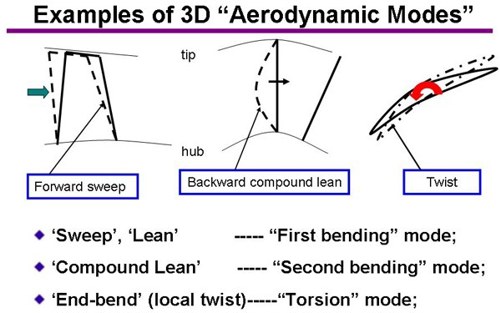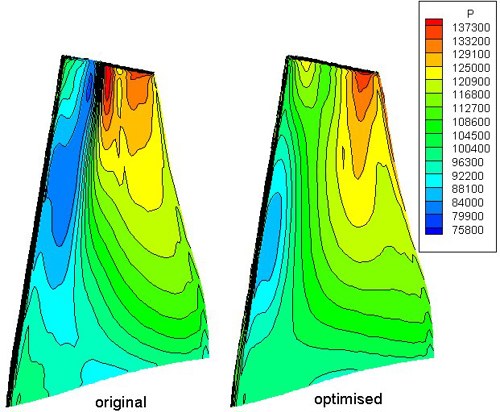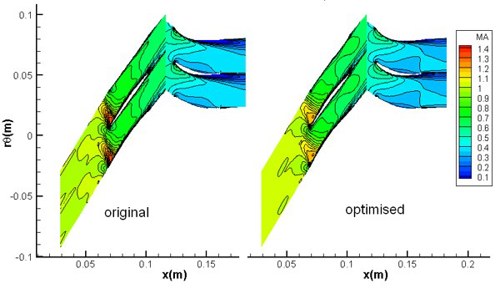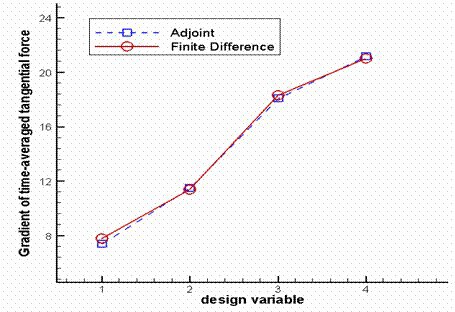Oxford Thermofluids Institute | Research - Research Groups: CFD Group, Design Optimization

Design Optimization with Component and Discipline Interactions
Aero-mechanical modal approach
Aero-mechanical Modal Approach to Aerodynamic Performance Optimization
A blading design optimization system has been developed using an aeromechanical approach and harmonic perturbation method. The developed system has the capability to optimize aero-thermal performance with constraints of mechanical and aeromechanical integrity at the same time. ‘Aerodynamic mode shape’ is introduced to describe geometry deformation so that both blade shape change perturbations for both the gradient sensitivity and the structural vibration analysis can be dealt with within an unified solver. A redesign practice of the NASA rotor-67 at the peak efficiency point shows that the aero thermal efficiency can be improved by 0.4%, whilst the maximum static stress has been increased by 33%. Aeromechanical analysis of the optimized blade shows that the aerodynamic damping of the least stable first flap mode is still well above the critical value though the natural frequencies of the first 5 modes have been reduced by 1-4%. The present finding highlights the need for more concurrent integrations of mechanics, aerodynamics and aeromechanics design optimization.

Adjoint blade aerodynamic optimization
Adjoint Aerodynamic Design Optimization for Multi-stage Turbomachinery Blades
Method Ingredients:
- A continuous Adjoint method has been developed based on a 3-D time-marching finite volume RANS solver. This enables the performance gradient sensitivities to be calculated very efficiently, particularly for situations with a large number of design variables.
- A novel adjoint ‘mixing-plane’ model has been developed. This model makes it possible to carry out the adjoint design optimization in a multi-stage environment.
- The optimization approach with the above capabilities has been implemented in a parallel mode, with which a simultaneous multi-point optimization can be conducted.



Concurrent aerodynamic-aeroelastic optimization
Concurrent Blade Aeromechanic and Aerodynamic Design Optimization (adjoint approach)
Why do we need to consider a concurrent design optimization? It is noted that some of existing aerodynamic design optimizations have been too focused on a single discipline area, tending to get diminishing returns. Also, one may often end up with such ‘over-designing’ as to exploit weakness of CFD rather than its strength. A concurrent design and optimization framework has been developed with a demonstrable working method. With the approach developed, both the blade ’steady’/mean aerodynamics (e.g. loss and efficiency) and aeroelastic (damping and/or dynamic response level) performance can be simultaneously evaluated. The nonlinear harmonic based adjoint method enables the aerodynamic and aeroelastic sensitivities to be obtained very efficiently. The test case results have heighted the appeal of a concurrent D/O approach.
The main method Ingredients:
- The nonlinear harmonic phase solution (He, 2008) enables steady (mean) and unsteady harmonic performances evaluated using 3 ‘steady-like’ solutions at 3 distinctive temporal phases (-90°, 0° , 90°). This basic formulation gives a unified framework for combined aerodynamic and aeroelastic design optimization.
- The unsteady harmonic adjoint formulation enables the sensitivities of steady (mean) and unsteady flow performances to be evaluated by solving 3 ‘steady-like’ adjoint equations at the 3 phases – a natural extension of steady adjoint solver.

